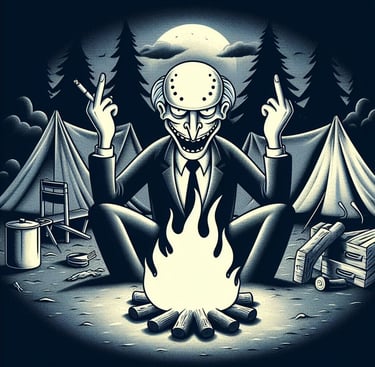Hash House Harriers: The Drinking Cult
An unfiltered look into the hidden, darker side of the Hash House Harriers, "The Drinking Cult" by Jay Dangerfield explores how a once lighthearted running and drinking group evolved into a toxic subculture plagued by drug abuse, sexual misconduct, and cult-like peer pressure — especially within the U.S. hashing community. Originally published on Medium, this article challenges the illusion of safety and belonging that draws many into the Hash, revealing the risks that often go unspoken.
Jay Dangerfield
4/29/20253 min read


Hash House Harriers: The Drinking Cult
By Jay Dangerfield
Originally published on Medium, October 21, 2021
Listen to the original article here
"A drinking club with a running problem."
It’s Friday night and about 15 Hashers gather under an overpass, drinking beer and enjoying the camaraderie of familiar faces. Some are dressed in strict running attire, others in street gear, while still others of all genders parade in tutus and tennis shoes. All are in good spirits and find a sense of relief seeing their drinking buddies at the same time every week.
At the appointed time — usually several minutes late — Hashers are told to "circle up" for a small ceremony where introductions are made, celebratory singing and drinking commence, and the Hash "Religious Advisor" sets the stage for an evening of exercise and fun by following a trail set forth by the "Hare."
Real names are only for the uninitiated. New participants are dubbed "Just Jeff" or "Just Alice," while seasoned members go by lewd or obscene nicknames. You’ll find doctors, lawyers, public officials, factory workers, and college students drinking and singing bawdy songs side by side.
In many kennels (local chapters), the Religious Advisor encourages the "Justs" to "show a body part, sing a song, or tell a joke." Most follow jovially as the Hash indoctrinates initiates into the group's mindset.
After about five runs ("hashes"), the group gathers at the end of a trail to formally initiate the "Just" by asking three questions:
Where was the Hash founded?
When was the Hash founded?
Who founded it?
(Answer: Kuala Lumpur, Malaysia, 1938, by British Army officer G. Allen Gispert.)
Upon successful answer (or drunkenly forgetting and being reminded), the naming process begins. Embarrassing stories and personal questions are asked, culminating in a new, often risqué nickname. The initiate is then doused in flour and beer, creating a thick paste that usually ruins their clothes — and copious drinking continues.
The Allure of Community
Hashing once offered a cathartic communal experience — a temporary reprieve from the pressures of daily life. In almost every major city worldwide, Hashers gather weekly. Many military members hash abroad near their bases, shedding the mantle of responsibility for a night.
At least, it used to be.
Today, as with much of society, cracks have appeared. Particularly in the U.S., the Hash House Harriers have shifted from a bawdy, tongue-in-cheek gathering to a hotbed of cultish behavior, hyper-sexuality, and substance abuse.
The Problems Today
While yesteryear’s Hashers joined to:
Promote physical fitness
Get rid of weekend hangovers
Acquire a good thirst and satisfy it in beer
Persuade older members they weren’t as old as they felt
…today’s U.S. Hasher often faces:
Hard drug introduction (Ecstasy, MDMA, Tier-1 illicit substances)
Peer pressure to use or risk ostracization
Rampant sexual misconduct, assault, and abuse
Leadership that is apathetic, uneducated, or complicit
A cult-like environment that preys on the vulnerable
Predators build rapport with leadership and enjoy impunity while using lewd traditions and drunken vulnerability as a guise for exploitation.
Fear and Illusion of Safety
Despite slogans like "No means no," the actual environment is one of fear, mistrust, and retaliation. Young males are often scapegoated, and arbitrary labels like "weird" or "creepy" are weaponized — often by the real predators — to deflect attention from themselves.
"Banning" individuals from Hash groups is now commonplace, not for protection, but as a tool to maintain toxic groupthink. Online groups like "Banned H3" revel in ostracizing those who don’t conform.
Cult Behavior and Military Influence
The need to belong keeps members complicit. In a group that glorifies public sexual acts and nudity with songs and "down-downs," many abandon their values to stay accepted.
The military angle complicates it further:
Young male military members flock to hashing for stress relief.
Leadership (often former Hashers themselves) turn a blind eye, viewing misconduct through a nostalgic, outdated lens.
Military bans on hashing (especially in Japan and Korea) occasionally arise after scandals but fail to address systemic issues.
Hashing becomes another system where tolerance of destructive behavior is enforced through peer pressure and fear of exclusion.
Final Thoughts
No matter where you live, a Hash group likely operates nearby. They represent a cross-section of society but reflect the same fear, anxiety, and intolerance that plague broader culture.
Many former and current Hashers, including the author, are victims of institutionalized sexual assault and general intolerance.
"If you are involved in the Hash, know that you are worthy of acceptance. You do not have to tolerate abuse. If you have a loved one involved, support them, and remind them they don't need the Hash House Harriers to belong."
Author: Jay Dangerfield
Original Publication: Medium Article - Hash House Harriers: The Drinking Cult
Publication Date: October 21, 2021



